For those of you who are not familiar with her work, Morgan Allender has a background in floristry and is an accomplished painter and gardener based in Adelaide Hills, South Australia. When I first started following Morgan (it’s been so long now I don’t remember the year!), she was primarily a floral designer, specializing in wedding and event work. The way she approached flowers and color in her arrangements made my heart ache.
 In 2014, I had the privilege of interviewing her for the blog and we talked about her design business, Tenth Meadow, and the seasonal flower movement in Australia, which were both starting to gain momentum at the time. You can read the interview here.
In 2014, I had the privilege of interviewing her for the blog and we talked about her design business, Tenth Meadow, and the seasonal flower movement in Australia, which were both starting to gain momentum at the time. You can read the interview here.
Only later did I discover that Morgan is also an extremely talented artist who creates large-scale oil paintings inspired by the flowers growing in her garden. I remember vividly when she announced she would be retiring as a florist to devote all her energy to her painting. It was such a brave, bold move and one that I deeply admired.
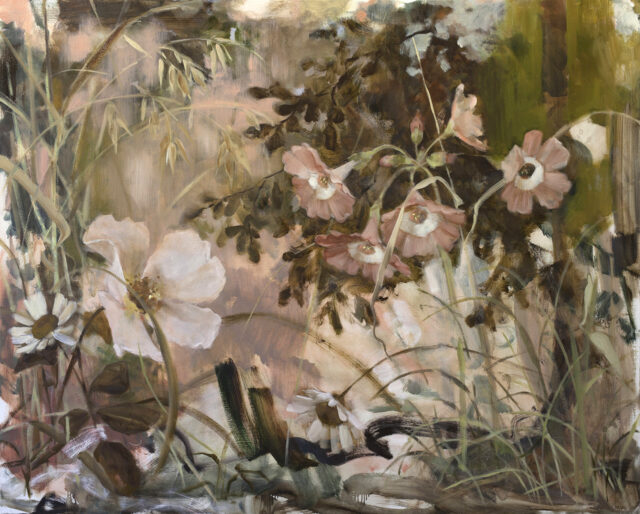 After I wrote my first book, Cut Flower Garden, I wanted to celebrate my accomplishment in some way, and the most special thing I could think of was one of Morgan’s magical paintings. Over the years this has become almost a ritual, and each time I’ve finished something that felt completely impossible (writing each book, creating our workshops, making both seasons of Growing Floret), I’ve marked the moment with a gift to myself—a piece of Morgan’s work. Her paintings now hang in every room of our home and feel like a window into her garden and soul.
After I wrote my first book, Cut Flower Garden, I wanted to celebrate my accomplishment in some way, and the most special thing I could think of was one of Morgan’s magical paintings. Over the years this has become almost a ritual, and each time I’ve finished something that felt completely impossible (writing each book, creating our workshops, making both seasons of Growing Floret), I’ve marked the moment with a gift to myself—a piece of Morgan’s work. Her paintings now hang in every room of our home and feel like a window into her garden and soul.
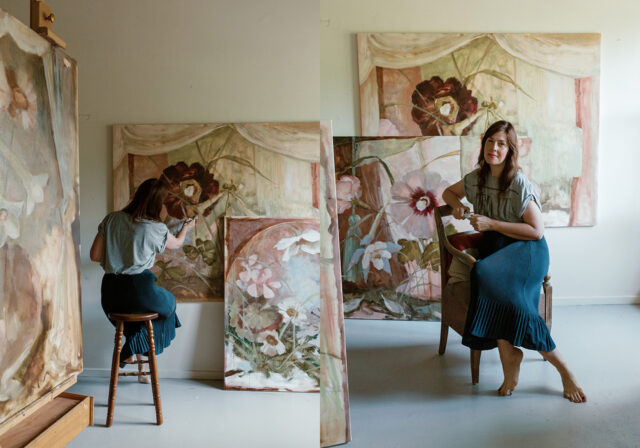 I recently had the opportunity to interview Morgan once again and catch up on all of the amazing things that have transpired since we last spoke. It is one of my favorite The Farmer & The {Florist} interviews to date, and I hope you’ll enjoy it as much as I did.
I recently had the opportunity to interview Morgan once again and catch up on all of the amazing things that have transpired since we last spoke. It is one of my favorite The Farmer & The {Florist} interviews to date, and I hope you’ll enjoy it as much as I did.
One of the most exciting things is that Morgan is offering a limited edition print that is available through November 16—so many of us have begged her to release this! You can preview it at the end of the interview, plus you can enter to win one for yourself.
Photo above by Georgy Keen Photography.
 Morgan, I’m so thrilled to have you back on the blog! Quite a lot has changed in this span of time. Can you tell us about how things have evolved since the last time we spoke here?
Morgan, I’m so thrilled to have you back on the blog! Quite a lot has changed in this span of time. Can you tell us about how things have evolved since the last time we spoke here?
Last time we spoke on this blog (11 years ago!!), I was running my floral design business, the Tenth Meadow, and also beginning to grow flowers here at our farm in the Adelaide Hills. That time in my life was an absolute whirlwind. Tenth Meadow started as a tiny business, with just me creating wilder floral arrangements for weddings, and very quickly became incredibly busy and much larger than I ever anticipated. I suppose that was a great thing, but I was unprepared and quickly became very burnt out from working so incredibly hard without having time to build up a supportive team to help me.
Photo above by Georgy Keen Photography.
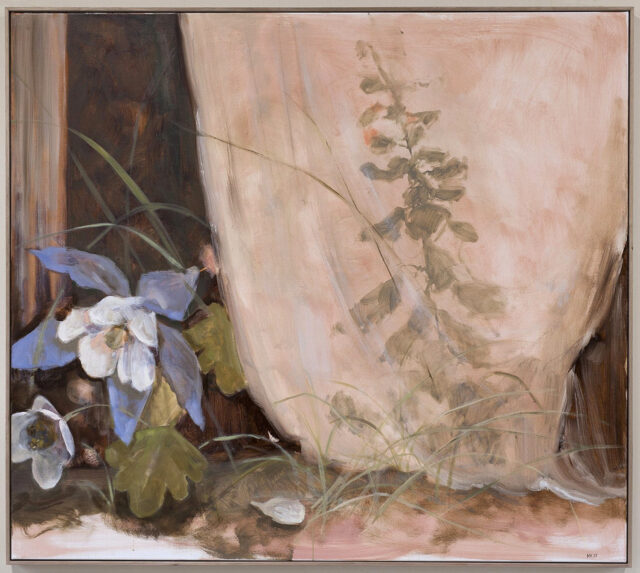 After a few years, I decided to press pause and return to painting full-time. It was a leap of faith that was ultimately helped along when I lost all of my supporting income and work during the 2020 pandemic lockdowns here in Australia. I thought, “Well it’s me and my paints now,” and I just jumped in with all my focus.
After a few years, I decided to press pause and return to painting full-time. It was a leap of faith that was ultimately helped along when I lost all of my supporting income and work during the 2020 pandemic lockdowns here in Australia. I thought, “Well it’s me and my paints now,” and I just jumped in with all my focus.
Now, a few years later, I am still a full-time artist, creating large-scale paintings here in my barn studio nestled at the top of my garden. My paintings are mainly plants, flowers, and trees and are definitely inspired by my time as a florist, as well as the large garden that I have created here over the past 15 years.
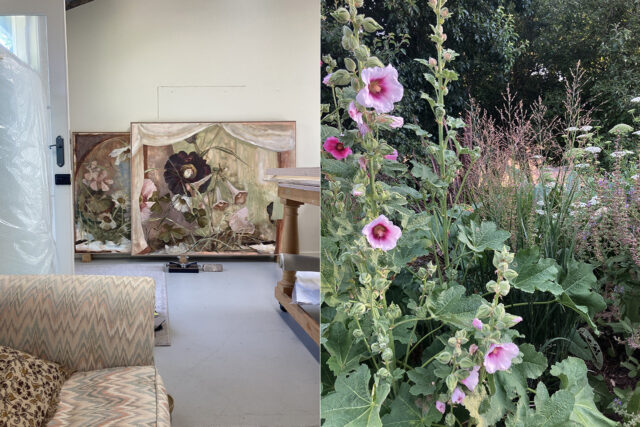 Can you take us behind the scenes of your work in the studio and discuss some of the parallels you see between gardening and painting? I know you typically work on multiple paintings simultaneously to create a body of work and that your garden and its colors provide what you’ve described as a “cyclical inspiration loop.” How do you trust in that intuitive process?
Can you take us behind the scenes of your work in the studio and discuss some of the parallels you see between gardening and painting? I know you typically work on multiple paintings simultaneously to create a body of work and that your garden and its colors provide what you’ve described as a “cyclical inspiration loop.” How do you trust in that intuitive process?
There’s a little path that winds up the hill from our cottage to the studio and it passes through the main swathes of garden beds, ducks through a narrow gap in a tall hedge, and skirts underneath some elderflower trees and some climbing roses that have wound their way up into the pears. I spend most of my working day going up and down this path for tea breaks, so while I’m working, I’m constantly experiencing the shifts of light in the garden. There is a natural dialogue between what is happening outside and what is appearing on the canvases in the studio.
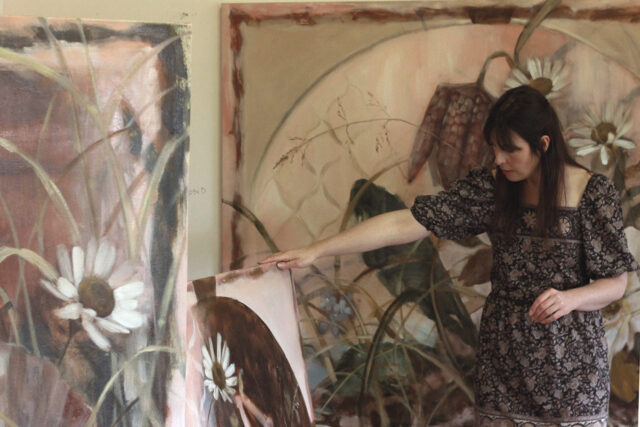 When I’m working on a suite or exhibition of paintings, I have multiple pieces on the go at once, so the studio gradually fills up with these large paintings until there isn’t enough space and they’re overlapping and jostling for space. It becomes a very immersive experience being surrounded on all sides by these giant painted flowers and trees and patches of sky. That’s when I most feel the symbiosis between the garden and the studio and the outside has truly come inside.
When I’m working on a suite or exhibition of paintings, I have multiple pieces on the go at once, so the studio gradually fills up with these large paintings until there isn’t enough space and they’re overlapping and jostling for space. It becomes a very immersive experience being surrounded on all sides by these giant painted flowers and trees and patches of sky. That’s when I most feel the symbiosis between the garden and the studio and the outside has truly come inside.
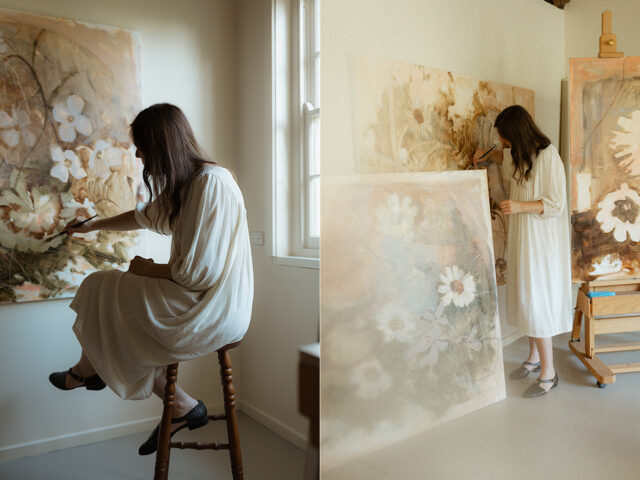 When you’re engaged in these intense creative periods, what do your days look like? How do your rhythms and priorities change?
When you’re engaged in these intense creative periods, what do your days look like? How do your rhythms and priorities change?
When I’m in it, I’m really in it, and I’ll work long days in a very disciplined way. The way I work is that I’ll wait until inspiration is really coming through and then I will go into the studio and let it pour out onto the canvases. I’m not painting the whole time—it would be exhausting! A lot of time in the process involves looking and reflecting, being with the paintings and feeling for what they might need next—maybe some green over in that corner, or a darker glaze over that section. It’s a very focused experience but I always stop for lunch and multiple cups of tea out in the garden to take a breath and reconnect.
Photo above by Georgy Keen Photography.
 You’re known for your large-scale oil paintings, but lately you’ve been experimenting with watercolor. How has creating using a new medium felt after spending so much time understanding and using oil paints? What brought about wanting to try something new?
You’re known for your large-scale oil paintings, but lately you’ve been experimenting with watercolor. How has creating using a new medium felt after spending so much time understanding and using oil paints? What brought about wanting to try something new?
It’s important to try new things in any practice to remain excited about what you’re doing. Change is good. Watercolour has always amazed and scared me. It’s a very different technique to oil paint and I’m definitely still learning. I’m drawn to the freeness that watercolour can offer—it’s light and transparent and that’s interesting to me. I’ve gotten to know oil paint very well over the years; it is now like an old friend whose secrets I mostly know.
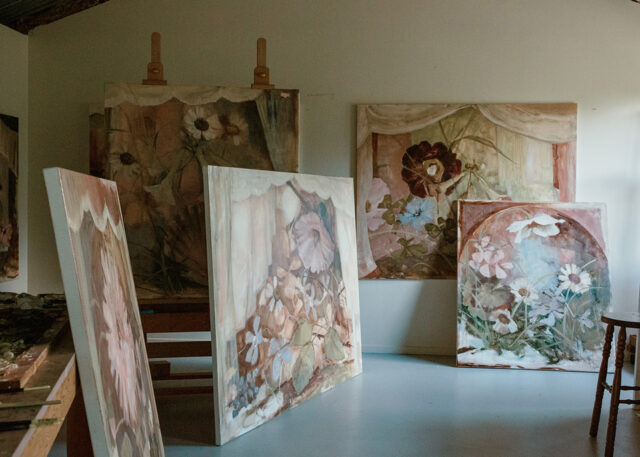 You’ve said, and I strongly agree, “I believe that art is something practical and natural to being human, and for everyone to engage with.” At Floret, I’ve talked about the benefits of engaging in a creative practice, whatever that might be. What advice would you give to someone who could use some words of encouragement to see and access that part of themselves?
You’ve said, and I strongly agree, “I believe that art is something practical and natural to being human, and for everyone to engage with.” At Floret, I’ve talked about the benefits of engaging in a creative practice, whatever that might be. What advice would you give to someone who could use some words of encouragement to see and access that part of themselves?
I think that creativity is an inherent and essential part of being a human being. I hear many people say to me, “Oh, I don’t have a creative bone in my body,” which is just entirely untrue, and I think it’s important to keep in mind two main things about creativity:
- It is not some rarefied trait bestowed on a lucky few. Sure, some people will have natural talents that set them apart, just like some people naturally excel at sports and some not so much. This doesn’t mean the rest of us can’t ever have fun in a game of tennis! Someone doesn’t have to be a professional artist or draw their income from a creative field in order to be creative, and not everyone will have the opportunity to make a living from their creations. It is actually more about setting time aside to use that right-hand side of the brain, to make things for fun and joy, and to play.
- Creativity can come in so many forms. It might be arranging some flowers, or cooking; it might be mowing bendy paths in your lawn, or stacking your firewood in a beautiful way. I think as adults we forget somewhere along the line to just make stuff for no reason other than to just enjoy it. And we need to allow ourselves to be creative without perfectionism and comparison, which essentially means we have to get comfortable with making things that might look bad! There is so much pressure in 2025 towards flawlessness. I think that is helped along by social media obviously, and perfectionism is really a form of fear that directly undermines creativity and joy. As someone who does make their living from my artistic creations and also struggles with perfectionism, I have realized how important it is to allow myself to experiment often, and to make mistakes. This is where new ideas bubble up from.
Photo above by Georgy Keen Photography.
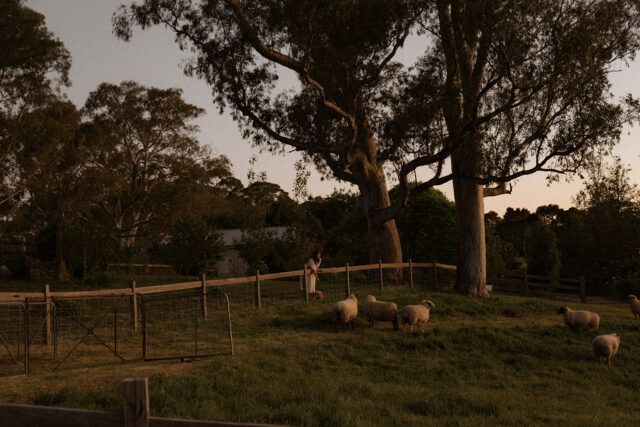 Your garden, home, and studio at Shepherd’s Rest are completely breathtaking and have been featured widely in magazines and books, as well as on television. How has Shepherd’s Rest grown and changed in the time since you moved there? What is your current favorite pocket of the property?
Your garden, home, and studio at Shepherd’s Rest are completely breathtaking and have been featured widely in magazines and books, as well as on television. How has Shepherd’s Rest grown and changed in the time since you moved there? What is your current favorite pocket of the property?
Immediately I think of the trees. Gardens, of course, take time to develop a sense of place, and they go through various stages along the way. When I began the garden here, it was a very exposed site, not many trees, no garden beds, just weeds and a mostly bare hillside. It was very windy and very hot in summer, so some of the first things I planted were the trees and hedges, in an effort to create some shelter for growing flowers and a sense of enclosure and calm.
Now, 15 years later, the garden feels like it has reached a sort of young maturity. The elaeagnus hedges are 6 to 10 feet high and full of blackbird nests, and the trees I planted, mostly crabapples, hawthorns, pears, and oaks, have intertwined to create a leafy ceiling across the garden. They are all in blossom right now and the effect is magical. In the centre of the garden near the cottage is a very, very old and enormous hawthorn tree. I have described it as a cathedral of birds because it is always teeming with life and somehow holy, and sitting underneath its branches is one of my favourite places on earth.
Photo above by Georgy Keen Photography.
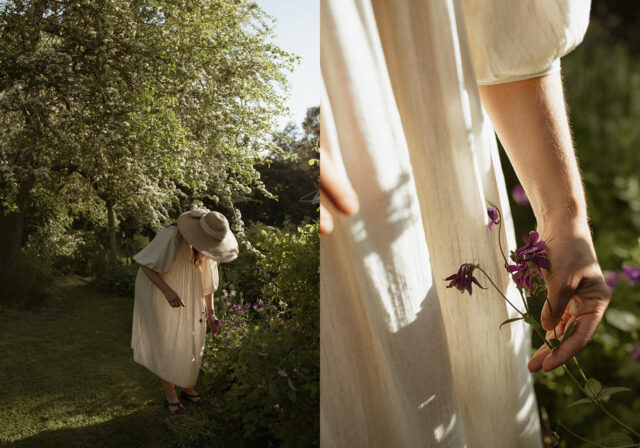 Your spring is just beginning in Australia. As we look ahead to planning our gardens in the Northern Hemisphere, can you share what you’re especially excited about growing in your garden this year?
Your spring is just beginning in Australia. As we look ahead to planning our gardens in the Northern Hemisphere, can you share what you’re especially excited about growing in your garden this year?
Ooo, well, for me right now it’s certain species pelargoniums . . . they really make my heart beat faster. My favourite is the chocolate peppermint pelargonium (Pelargonium tomentosum). It has magical, huge, fuzzy leaves with dark brown patterning and the finest haze of tiny pink flowers, and it spreads luxuriantly in the dappled light underneath small trees. They are great in floral arrangements. Most pelargoniums are hardy here all year round; they don’t need sheltering in our mild winter and are also strong in our extremely hot weather. They are now dotted throughout the garden in places that other plants find difficult and really are amazing plants. I have fantasies about opening a specialist pelargonium nursery when I am an old lady . . .
Photo above by Georgy Keen Photography.
 And spring here is really all about the roses—I planted lots when I started the garden but have gradually edited them down over the years as the garden has become more shaded. I like a rose that can romp over a shed or up through a tree, and those that have a wild habit. Particular favourites are Rosa ‘Dupontii’, ‘Fruhlingsgold’, Rosa filipes ‘Kiftsgate’, ‘Francis E. Lester’, and ‘Felicite et Perpetue’. The last two grow over the verandahs of the cottage with an abundance of flowers.
And spring here is really all about the roses—I planted lots when I started the garden but have gradually edited them down over the years as the garden has become more shaded. I like a rose that can romp over a shed or up through a tree, and those that have a wild habit. Particular favourites are Rosa ‘Dupontii’, ‘Fruhlingsgold’, Rosa filipes ‘Kiftsgate’, ‘Francis E. Lester’, and ‘Felicite et Perpetue’. The last two grow over the verandahs of the cottage with an abundance of flowers.
Photo above by Georgy Keen Photography.
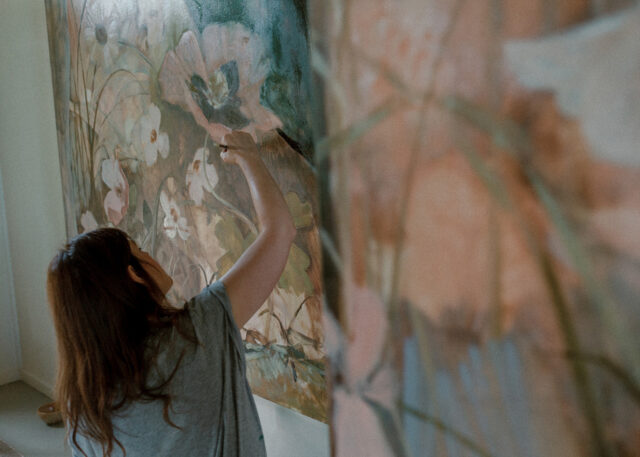 In South Australia, I understand you’re just ending the driest 15-month spell since weather records began, and that, to some extent, inspired your most recent collection of paintings, Of Pond & Bower, which is filled with water imagery. I know you created a new garden area to experiment with drought-tolerant plants. Can you talk about what varieties you’re growing in this space and the successes, failures, and surprises you’ve had over the past 2 years?
In South Australia, I understand you’re just ending the driest 15-month spell since weather records began, and that, to some extent, inspired your most recent collection of paintings, Of Pond & Bower, which is filled with water imagery. I know you created a new garden area to experiment with drought-tolerant plants. Can you talk about what varieties you’re growing in this space and the successes, failures, and surprises you’ve had over the past 2 years?
With summers getting hotter and drier here, this area is an experimental trial garden of sorts, to see what varieties will flourish with only winter/spring rain and a maximum of two to three waterings per summer. It reaches 42 degrees Celsius here on some days, so the plants have to adapt to these conditions, although I do mulch heavily with large gravel and also thick layers of straw. The results have been remarkable and unexpected in the sense that some plants that I thought would perish have actually flourished the most.
My favourite recommendations for anyone creating a low-water but pretty ornamental garden would be salvia ‘Shangri-La’ (amazing!), gaura (Oenothera lindheimeri), cardoons, miscanthus ‘Cosmopolitan’, Tulbaghia violacea, bearded iris, various teucrium, and phormium. I also planted quite a few Australian plants: Thryptomene saxicola, Melaleuca nesophila, and Correa alba have been standouts.
Photo above by Georgy Keen Photography.
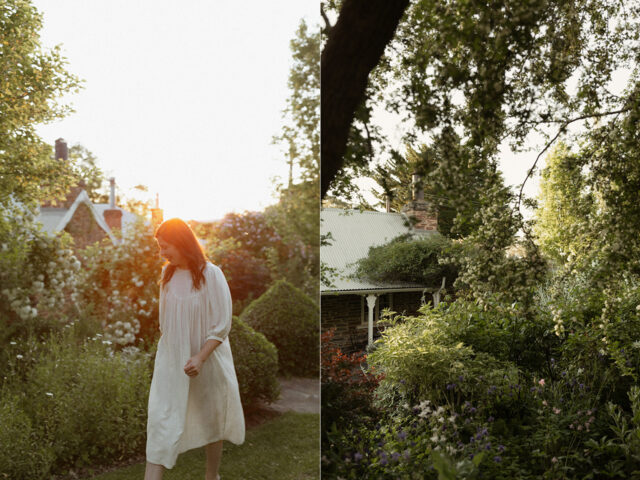 It sounds like the rabbits have been particularly maddening in the garden this year, but have also been an unexpected “positive force for creative change.” What lessons have you learned from dealing with what you’ve (understandably!) labeled the “rabbit plague” that others could take into their own gardens?
It sounds like the rabbits have been particularly maddening in the garden this year, but have also been an unexpected “positive force for creative change.” What lessons have you learned from dealing with what you’ve (understandably!) labeled the “rabbit plague” that others could take into their own gardens?
This is an example of “Life lessons from the garden.” I think these challenges come in cycles, and if it wasn’t rabbits, it would be drought, or insects, or frost, etc. I remind myself that the garden always adapts and bends and keeps on flourishing. When things go wrong in the garden (and in life!), as they inevitably do sometimes, when the dust settles, there’s often been a space created for something else to flow in. If a tree falls over in a storm, it then creates a space for light to get down and reach the soil so that other plants can grow up in its place.
I will be honest, though—it’s taken some deep breaths and meditation to reach this place of grace about the rabbits and there’s been some swear words muttered! Interestingly, though, many of the plants they have eaten were the more tender plants that were less suited to the environment here, and it’s been really reassuring to shift my focus to what plants are still flourishing and plant more of those.
Photo above by Georgy Keen Photography.
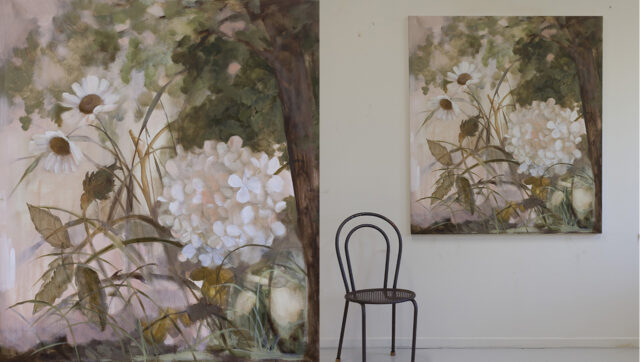 You described your past winter as a period of reflection and reset. As we’re moving into our winter here, do you have any advice for those of us who are hoping to find a slower pace and make time for the same? How do you stay dedicated to taking care of yourself and pursuing new and creative endeavors?
You described your past winter as a period of reflection and reset. As we’re moving into our winter here, do you have any advice for those of us who are hoping to find a slower pace and make time for the same? How do you stay dedicated to taking care of yourself and pursuing new and creative endeavors?
Nature is always the perfect teacher and it shows us that periods of rest and recalibration are as essential to growth as the opposite periods of action and abundance. I have always had bursts of really hard work followed by periods of reflection and pause. Those quieter periods are when I gather ideas and experiences outside the studio that then feed back into the artwork. It might be reading a book or travelling, or it might just be doing the laundry and having a cup of tea.
I think art arrives out of all the moments of life, even the mundane, and stillness is required to hear the whispers of inspiration when they are starting to come through. Journals and sketchbooks are a wonderful reflection tool for recording tiny flashes of inspiration and listening to your inner thoughts and ideas.
 You’ve just completed a meditation teacher training with a yoga studio in Melbourne, with an emphasis on connection to creativity and nature. How was that experience, and what do you hope to do with it?
You’ve just completed a meditation teacher training with a yoga studio in Melbourne, with an emphasis on connection to creativity and nature. How was that experience, and what do you hope to do with it?
I did it as a gift to myself during a quite challenging year, really as a way to carve out some time for stillness, and to deepen some aspects of my own yoga practice. I don’t think I ever intended that I would go on and be a teacher. Like many great experiences, I entered it with a sense of curiosity and no preconceived expectations. What has emerged, though, has been a very strong desire to share what I have learned, especially with other artists who are seeking pathways into creative flow.
For a few years now, I have been meditating before I begin working in the studio as a way of calming my mind and quieting any overly analytical thoughts that might get in the way while I am working. Often this happens out in the garden. People always tell me that they find my paintings very calming, and I think that’s because they are created when I’m in a very peaceful state, or have been sitting in nature, and this is somehow translated into the artwork.
Photo above by Georgy Keen Photography.
 I love your newsletter and blog—you share such thoughtful insights and have a beautiful way with words. Would you ever be interested in authoring a book in the future?
I love your newsletter and blog—you share such thoughtful insights and have a beautiful way with words. Would you ever be interested in authoring a book in the future?
Oh my goodness, I love to write and there are definitely at least two books bubbling away at the back of my mind. I would love to write a book for others about the creative process—the lessons and tools I have developed over 20 years of being an artist that help navigate the highs and lows of a creative life. And I’d love to write a book about nature, art, and meditation . . .
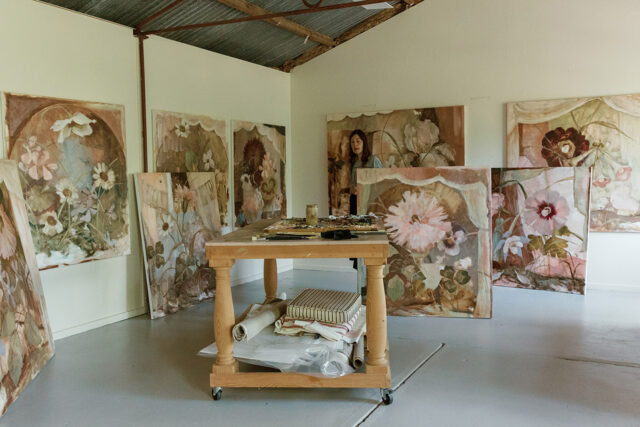 I’m so excited that you’ve just released a print for the holiday season, which isn’t something you’ve done very often. Can you talk a little about this special piece of work and how we can get our hands on it?
I’m so excited that you’ve just released a print for the holiday season, which isn’t something you’ve done very often. Can you talk a little about this special piece of work and how we can get our hands on it?
Yes, I hope this print will whisper to the hearts of flower lovers and garden people. It’s of a painting I made that features all of my most favourite flowers: striped antique roses, dark hellebores, oxeye daisies, and, of course, pelargoniums. I made this piece as spring was just emerging in the garden with swathes of hellebores and the occasional rose, and the air had that faint sense of warmth and possibility when you know that change is just around the corner.
This one is available over at my website here for a few more days, until November 16. I am shipping them internationally to arrive in plenty of time for holiday gifts.
Thank you, Erin—your questions have been so thoughtful and considered. It’s been a true joy.
Thank you, Morgan. I’ve loved catching up with you and learning more about your garden and your latest artwork. I can’t wait to read your book someday!
Photo above by Georgy Keen Photography.
 Morgan has generously offered two of her fine art prints to give away to Floret readers. For a chance to win, post a comment below telling us what part of Morgan’s interview inspired you the most or describe a simple, creative practice that brings you joy. Winners will be announced on November 18.
Morgan has generously offered two of her fine art prints to give away to Floret readers. For a chance to win, post a comment below telling us what part of Morgan’s interview inspired you the most or describe a simple, creative practice that brings you joy. Winners will be announced on November 18.
To learn more and connect with Morgan, be sure to follow her on Instagram and visit her website, where you can sign up for her beautiful newsletter and view her current work for sale.
Please note: If your comment doesn’t show up right away, sit tight; we have a spam filter that requires us to approve comments before they are published.
Floret only lists companies and products that we love, use, and recommend. All opinions expressed here are our own, and Floret does not offer sponsored content or accept money for editorial reviews. If you buy something using the retail links in this post, Floret may receive a small commission. Thank you for your support!



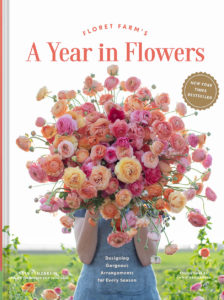
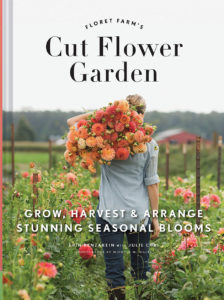


Join the Conversation